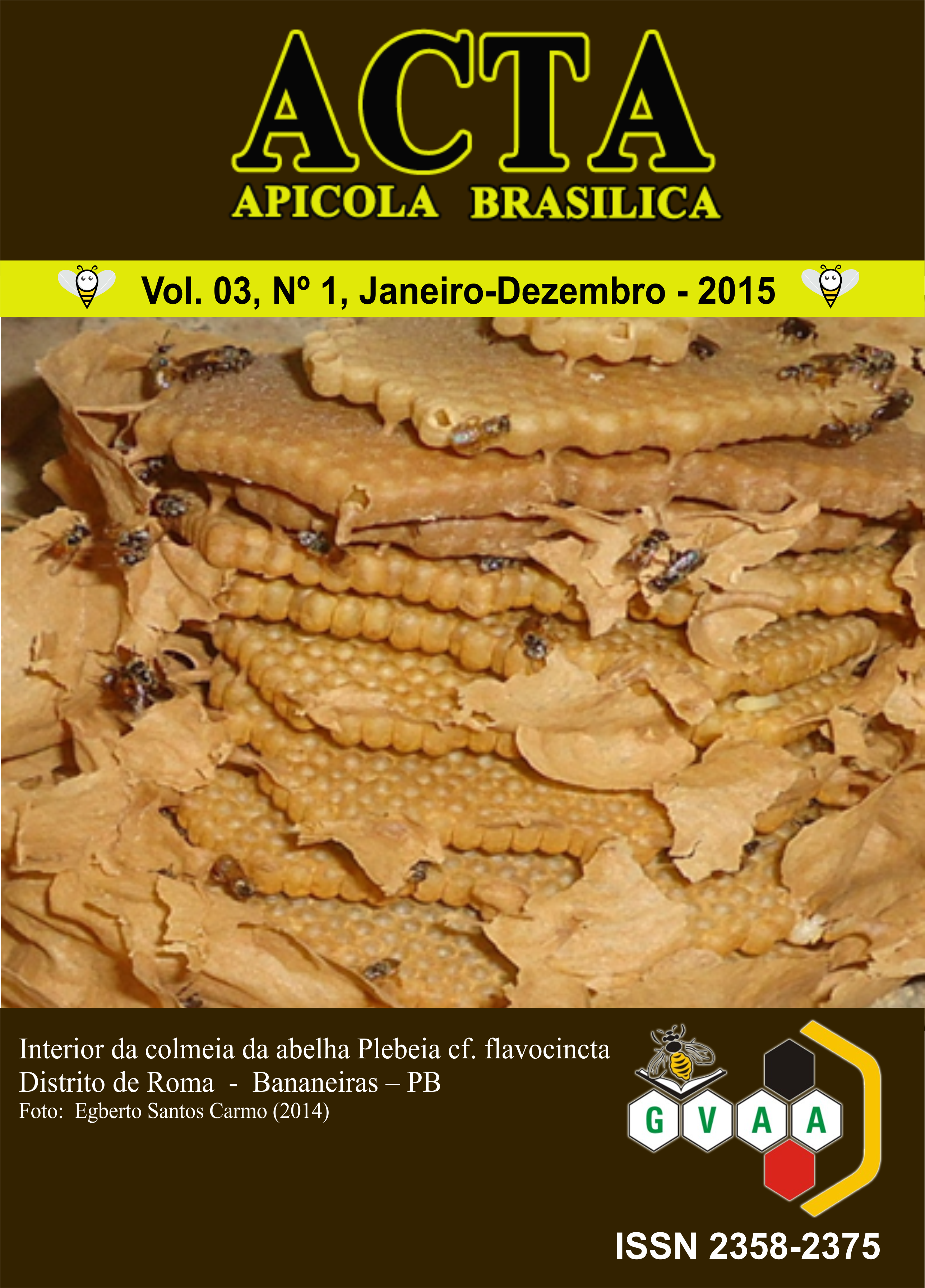Parameter avaliation of quality and thermal stability of honey produced in Sousa-PB region
DOI:
https://doi.org/10.18378/aab.v3i1.3537Keywords:
Chemical composition, Quality, Mel, ThermogravimetryAbstract
Much of the honey produced in the city of Sousa-PB, and neighboring towns is sold without nutritional labeling or record, especially in free or informal trade fairs. Facts that increase the risk of tampering and leave consumers unprotected. After harvesting, honey continues to suffer physical, chemical, microbiological and sensory changes. This creates the need to produce it within the highest levels of quality, controlling all stages of processing, so you can guarantee a good quality product. Inserted in this context, this paper aims to physico-chemical, microbiological characterization and thermal stability of honey bee Apis mellifera produced and marketed in the region of Sousa-PB, and compare their physicochemical properties with the standards established by Brazilian legislation and quality control of honey. The physico-chemical and microbiological analyzes were performed at the Federal Institute of Education, Science and Technology of Paraiba Sousa Campus. The results showed that the moisture content ranged from 16 to 20.7%, while respecting the limits required by the Brazilian legislation. In the determination of ash all samples are in agreement with the laws,. Among all averages, the biggest change was highlighted for acidity which had large difference between the minimum and maximum average 27.23 75.93 meq.kg-1. The TG / DTG curves showed five stages of thermal decomposition behaviors similar thermal. The parameters analyzed in this study are mostly within the standards required by Brazilian legislation for honey and according to the microbiological analyzes honey is not contaminated, thus being suitable for consumption.
Downloads
References
AZEREDO, L. C.; AZEREDO, M. A. A.; BESER, L. B. de O.; COSTA, V. C. S.; SILVA, V. A. G Características físico-químicas de amostras de méis de melíponas coletadas no Estado de Tocantins. In: Congresso Brasileiro de Apicultura, 2000, Florianópolis SC Anais... Florianópolis SC. 2000.
BRASIL. Ministério da Agricultura, Pecuária e Abastecimento. Instrução Normativa nº 11, de 20 de outubro de 2000. Regulamento Técnico de identidade e qualidade do mel. Diário Oficial da República Federativa do Brasil, Brasília, DF, 23 out. 2000. Disponível em: <http://extranet.agricultura.gov.br/ sislegis-consulta/servlet/VisualizarAnexo?id=1690>. Acesso em: 06 junh. 2014.
CAMPOS, G. Melato no mel e sua determinação através dediferentes metodologias: (Tese de Doutorado em Ciência Animal), Escola de Veterinária - UFMG, Belo Horizonte, 2010.
CHITARRA, M.I.F. Alimentos minimamente processados. Lavras: UFLA/FAEPE, 93 p. Texto acadêmico tecnologia e qualidade de alimentos vegetais. 2005.
FELSNER, M. L.; CANO, C. B.; MATOS J. R.,; ALMEIDA-MURADIAN, L. B.; BRUNS, R. E. Optimization of Thermogravimetric Analysis of Ash Content in Honey. J. Braz. Chem. Soc., Vol. 15, No. 6, 797-802, 2004.
FILHO, J. P. A.; MACHADO, A. V.; ALVES, F. M. S. Estudo físico-químico e de qualidade do mel de abelha comercializado no município de Pombal – PB. Rev.Artigo Científico. Revista Verde (Mossoró – RN – Brasil) v.6, n.3, p.83 - 90 julho/setembro de 2011.
SEGISMUNDO, N. R.; FILHO, E. M.; MATOS, J. R.; MERCURI, L. P.Caracterizaçãotermoanalítica e físico-química de méis de Apismellifera.32a Reunião Anual da Sociedade Brasileira de Química, 2008.
Silva, R.A.; Rodrigues, L.M.F.M.; Lima, A.; Camargo, R.C.R. 2006. Avaliação da qualidade do mel de abelha Apis mellifera produzido no município de Picos, estado do Piauí, Brasil. Revista Higiene Alimentar, 20, 90-94.
SILVA, L. R.; VIDEIRA, R.; MONTEIRO, A. P.; VALENTÃO, P.; ANDRADE, P. B. Honey from Luso region (Portugal): Physicochemical characteristics and mineral contents. Microchemical Journal, v. 93, p. 73–77, 2010.
SILVA, Mariana Borges de Lima da. Diagnóstico do sistema de produção e qualidade do mel de Apis melífera . 2007. 80f. Dissertação (Mestrado em Tecnologia de Alimentos) –Universidade Federal de Viçosa, Viçosa, 2007.
SNOWDON, J. A.; CLIVER, D. O. Microrganisms in honey.International Journal Food of Microbiology, v.31, p.1-26, 1996.
VARGAS, T. Avaliação da Qualidade do Mel Produzido na Região dos Campos Gerais do Paraná. 2006. 134 f. Dissertação (Mestrado em Ciência e Tecnologia de Alimentos)- Universidade Estadual de Ponta Grossa, Ponta Grossa, 2006.













